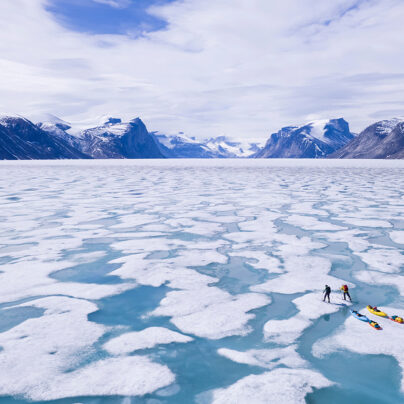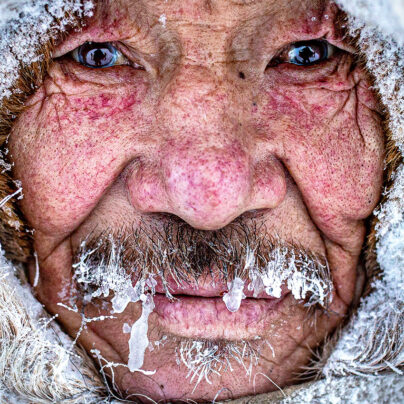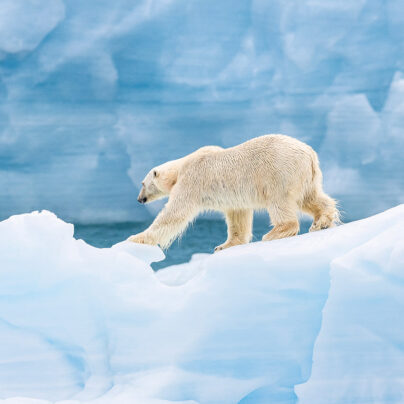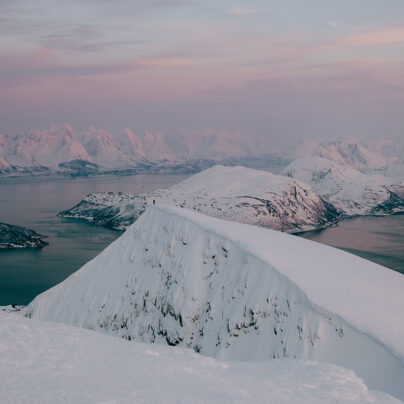A White Dream
In Search of Mountain Goats in the Yukon
Story & Photography by Mathieu Le Lay and Jérémie Villet // Written by Alex Roddie
‘Tracking is what I love most about my quests. I see the tracks of an animal, and I begin to imagine a story.’
Mathieu and I are high on a mountain in the Yukon, suffering and struggling through endless snow because we are seeking a ghost. Some of the most worthwhile moments of my life have been close to wild and secretive creatures that make their home in the cold places of the world. I am a wildlife photographer. But taking photographs is not truly why I am here. What I am seeking is very elusive, very special.
Wan light filters through the yellow walls of my tent, which thrash in a wind that hasn’t let up all night. Nowhere on this mountain is flat, and Mathieu’s tent, a few metres away, is just as tilted as mine. Soon he’ll be here with his camera and another day will begin – a third day of agonisingly slow progress up slopes laden with fresh snow, of scrutinising the cliffs above for signs of the animals I seek. The magnificent bearded mountain goats are up there somewhere. White spirits floating through a white world.
I delay the moment of getting out of my sleeping bag for as long as possible. Intense cold nips at my nose, and with every gust a fine snow of frozen condensation falls to coat me and my gear. My gloves, when I try to force them on, are rock solid. And Mathieu is here already with his camera: an indistinct figure in the twilight, bundled up in layers behind his camera lens. The glass reflects my own exhausted and cold-pinched face. ‘I bet I look like shit,’ I tell him, and without missing a beat he replies, ‘Yeah, you do.’ We both laugh. At least, after all this time, all this suffering, we can still crack a joke.



Before setting out again, I take a GPS reading inside my tent. ‘In case the blizzard buries it before we get back,’ I tell Mathieu. And then, muffled up against the biting cold and laden down with heavy camera equipment and heavier packs, we resume our climb.
The snow is even deeper than yesterday. With every footstep, I sink to my knees, my thighs, my stomach. I’m cutting a long, slow trench up the mountain – but Mathieu and I can’t take turns in the lead, because he is carving his own trench some distance away. And as we approach the sensitive animals, he holds back, filming from afar. We must take every precaution to avoid disturbance.
Each time I look up, I see the bearded faces of several goats staring down at me from cliffs far above. At this rate, an hour or more to climb 100m, it’ll be dark before we get to them. And besides, the animals know we are here. They watch with calm indifference. Up there beneath the cliffs the slope is even steeper, the snowpack is crumbling beneath my feet, and suddenly I begin to think about avalanche risk.
Snowflakes whirl. Looking up again, brushing snow from my face, the animals are gone. I let it burn for a moment – the frustration, the impatience – but just for a moment. This has been a long quest. Days on this mountain, weeks wandering the Yukon, learning to see, feel, be more like the goats. Mathieu has been joking that I even look like a goat now, with my yak-wool hat and neck warmer, and he stalks me with his long lens, out there in the blizzard, as if I were a wild animal myself. Sometimes I feel startlingly like one.
I know where the goats will have gone, climbing to higher, steeper ground – where I cannot follow. They have hooves. I don’t. Today is, once again, not the day. After one last glance upwards, I turn and begin to descend.



Whitehorse, Yukon. Three weeks earlier.
‘Nobody has ever come here to photograph mountain goats before. You’re the first one. So nobody knows where to go or what to do.’
To hear these words from Peter Mather, a renowned Yukon-based wildlife photographer whose work I admire, is a jolt. Reality hasn’t sunk in yet. Here in Whitehorse gathering equipment and food for the expedition, snow is piling up in the street, but I know that it will be much, much colder out there in the mountains once Mathieu and I leave civilisation behind.
We meet in a bookshop filled with guidebooks, maps, and photo books – including some by Peter. I feel like I know him a little through his work, and it’s good to find a friendly face as I prepare for one of the most challenging journeys of my life. But I’ve really come to ask for his advice about photographing the goats. It’s a surprise that Peter has never shot them. ‘We don’t have many in the Yukon,’ he says, ‘and in the winter it’s really hard. I don’t even know of people who photograph them in the summer, but in the winter…’ He lets that trail off with a laugh.
We unfold a map and he shows me a mountain where he has seen goats. Then he points out a settlement called Carcross. ‘There’s a carver and hunter here, Keith, you should meet if you can. The Tagish People hunt mountain goats. They know where they are.’ I know that hunting is a big part of the culture here; back home in France it is controversial. Mathieu and I have both diligently studied techniques for practising wildlife photography with minimal disturbance, attuning ourselves to the landscape and ecosystem. But hunters know the wildlife and the area. This information could make all the difference in our journey.
***
The purpose of wildlife photography is to disappear. For that you need to hide, to anticipate the wind so that your scent is blown away from the animal. You need to sit under a tree without thinking about your cold feet or what you’re going to do an hour from now. Then you’ll see a squirrel jumping from one branch to another. Nature, having accepted your presence, will resume its normal course. Now you’re part of it. And there is nothing more beautiful than to see a wolf or lynx pass by without noticing you.
Our descent from the mountain is not the first time we have returned empty-handed on this trip. I wonder if it will be the last. But yesterday at our camping spot I had scanned the mountain on the opposite side of the valley with my binoculars, and through a veil of falling snow I’d seen what looked like tracks – and then goats. Four of them on a snow slope framed by stands of conifers. Another day, another daunting climb into the cold.
At the bottom of the valley between the two peaks is a frozen lake. We must cross this vast sweep of white with the pulka, but to do so while the mountain ghosts above are watching would be futile. We’ll be highly visible on the snowed-over lake. So we wait. For darkness, or for the animals to move out of sight. The full moon is shining down on a landscape of quiet tranquillity before I feel confident making the move. As I pull the pulka towards the cover offered by dense forest on the far shore, I feel calm, at peace – and yet there is a sense of crossing an invisible threshold, a crossing we can only make with due humility, permission, and sensitivity.
As we search for somewhere hidden to pitch tents on the far side, the aurora blazes green upon us, and I know that waiting to cross was the right choice, despite my eagerness to be making real progress. There is no concept of progress in nature. Without respect and patience we can never be anything but strangers here.



Carcross, Yukon. Two weeks earlier.
Snow lies deep in the village as I walk between buildings painted with elaborate Tagish murals to Keith’s workshop. I knock and enter. A barrel-chested man with a raven-black ponytail is working, carving a piece of wood with strong, calloused hands. He gets up to welcome me. Standing in this space, surrounded by chunks of timber, half-finished pieces, and the warm smell of wood shavings, I feel slight and insubstantial – a feeling magnified by Keith’s powerful handshake.
We talk about Carcross, the village at the confluence of four valleys. ‘It used to be called Caribou Crossing,’ he tells me. ‘Tagish People used to come here to harvest the caribou. We are the people of the caribou.’ As he says this I notice a huge caribou mural he has been working on, carving out a stylised animal in relief from a wooden slab metres wide. Again I feel the differences in culture – here hunting is simply part of life. And as I look around the workshop I realise that almost every carving represents a creature that is hunted. But a deep reverence and respect for these animals is tangible here, even if it is different to my own.
Soon, conversation moves to the mountain goat, and I begin to see that our differences are not so great after all. ‘As a carver, I’ve been taught many stories. The goat lives in a realm where the sky touches the earth, and no human can go there.’ He shows me the raven mask he is carving from yellow cedar. ‘You have to learn to draw before you can carve, learn to visualise it. When I come in here and start carving, the whole world disappears. I mind-travel. It’s like being in nature – everything disappears around you. You have to have a connection to it.’ Now Keith shows me a sheep he has carved from a gigantic sheep’s horn. ‘I go up to watch them fight, dressed in pure white against the snow.’ And I tell him that I do exactly the same.
We leave the workshop and walk through the village, soon reaching an open space where a totem pole reaches into the sky – it’s three, four times bigger than I could have imagined possible, richly decorated with the likenesses of animals. I see a mountain goat, its lips and horns and hooves painted black.
‘The legend goes that the animal mother built a hammock from the four mountain peaks, and then right above Carcross she created all the animals.’ We stare up in awe. All at once I am struck by the connection between people, place, creatures – it is more profound than I had expected. ‘I always wanted to carve mountain goats,’ Keith goes on, ‘and in my 40 years of carving I think this is the piece I’m happiest with. It’s a very spiritual place for us. The centre of our universe.’
Only now that he has communicated the true nature of this spiritual connection, I sense, will he be happy giving me some practical advice. He points to a distant snowy peak – one of the four upon which the animal mother suspended her hammock. ‘We go hunting sheep over there. And if you go that way,’ – he points to another mountain – ‘you will find goats.’


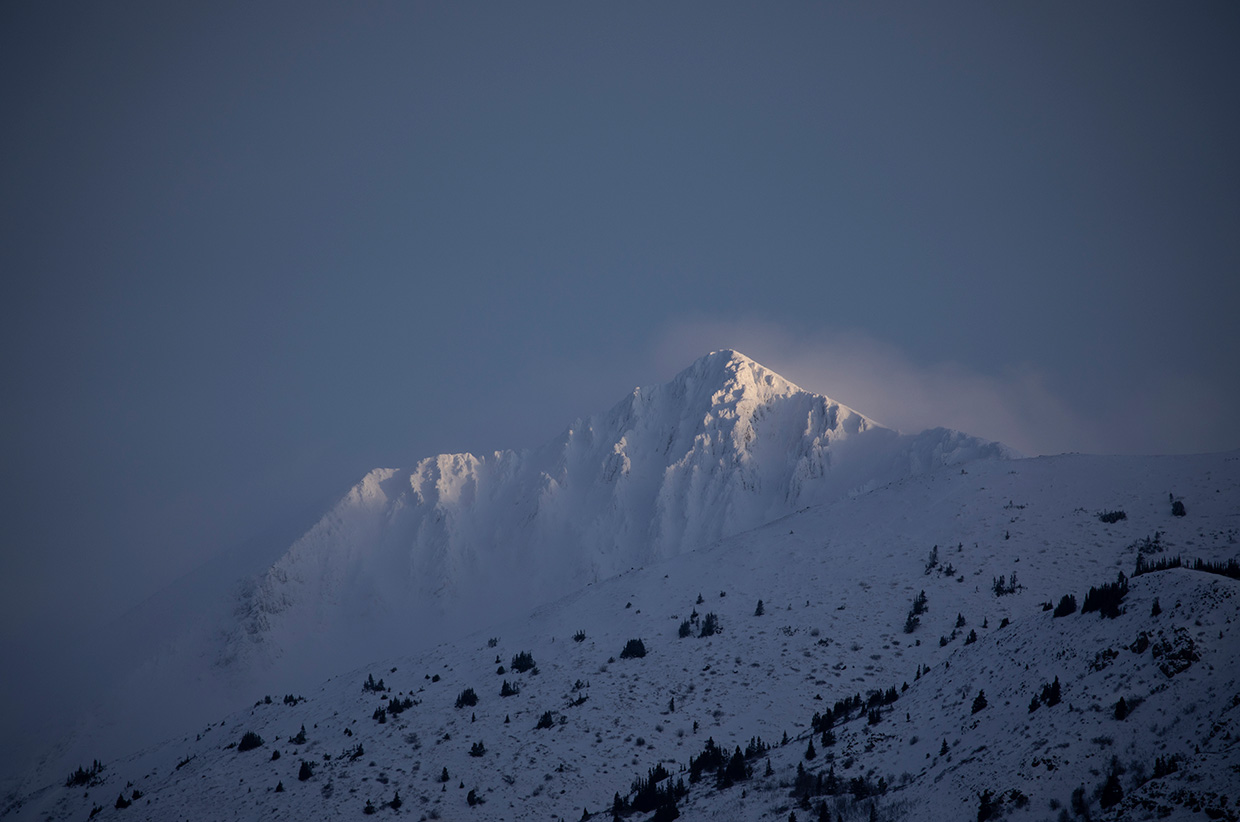
For all this time, I have been looking for the immaculate moment when everything becomes white: foreground, background, subject, and myself, an invisible but active participant in the scene. A photographic translation of emotion and connection. My feelings are complex and hard to articulate after such a long and wide-ranging quest, but in the snow and silence of this mountain I hope to express them at last.
I’ve been tracking the goats all morning. This time I know that I am close. Mathieu hangs well back to avoid any disturbance, and perhaps also he senses that I need solitude for this. A snag of white fur on a frosted branch speaks to me – a microcosm of the final anticipated moment.
Suddenly on the ridge ahead there it is: a white shape looking at me, huge and bulky in size but delicate in form against the white, like a charcoal sketch of some unimaginable prehistoric creature. Seen at such close quarters, his features shapeshift between aspects of different animals – the face and horns and beard of a muscular and primeval antelope, the body and pelt of a polar bear. But he has seen me and now I cannot move until he gives me leave to do so. We are transfixed there together, an electric bond of eye contact and mutual curiosity, until he turns away and I can get into position with my telephoto lens. It is right that this is the way of things. After all I have seen and learnt, to take the photo first would have felt deeply wrong.
Now I focus on composition. I forget that I am cold. The pure white of everything, the white within white I have long imagined, embraces and amplifies the silence. The mountain ghost fills my viewfinder and I try to translate the experiences and emotions of all the previous weeks. The animal disappears and reappears in the blizzard, an ethereal but animate spirit. Just as I have visualised for so long.
For me, a great photo is not about adding elements – it is when there is nothing more to take away. Although I know that the images cannot reflect the full depth of my emotions, I am satisfied that I’ve come so close to the animal I have sought for so long. After all the effort, doubt, and pain, I have met with the mountain goat and looked into his eyes.
First published in Sidetracked Volume 26
Mathieu Le Lay’s film depicting Jérémie’s journey across the Yukon, A White Dream (2021), was awarded Best Adventure & Exploration Film at the Banff Mountain Film Festival 2022, and has won more than 20 other awards internationally.
Story and photography: Jeremie Villet // @jeremievillet
And Mathieu Le Lay // @mathieulelay
Written by Alex Roddie // @alex_roddie




